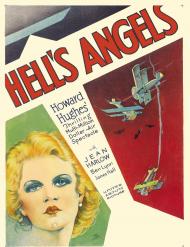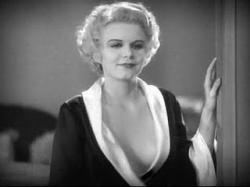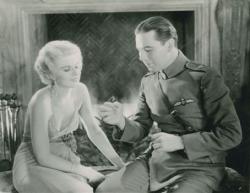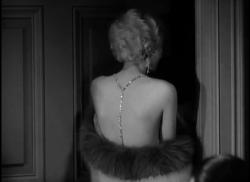Movie Review
Hell's Angels
The first multi-million dollars talking picture -- tremendous in size -- shocking in its relentless realism.
US Release Date: 05-27-1930
Directed by: Howard Hughes and James Whale
Starring▸▾
- Ben Lyon, as
- Monte Rutledge
- James Hall, as
- Roy Rutledge
- Jean Harlow, as
- Helen
- John Darrow, as
- Karl Armstedt
- Lucien Prival, as
- Baron Von Kranz
- Frank Clarke, as
- Lt. von Bruen
- Roy Wilson, as
- Baldy Maloney
- Douglas Gilmore, as
- Capt. Redfield
- Jane Winton, as
- Baroness Von Kranz
- Evelyn Hall as
- Lady Randolph
![3 star[s] out of 4](http://www.threemoviebuffs.com/static/images/global/featured_gold_stars.png)

Jean Harlow in Howard Hughes' Hell's Angels.
Hell's Angels is famous for many things. It was the most expensive movie ever produced at the time. Producer/Director/Aviator Howard Hughes famously shut down the filming when sound became big and went back at a high cost to refilm it as a talkie. It features some amazing arial photography. Two pilots and one mechanic died while filming the movie and Hughes himself performed one air stunt, when his stunt pilots refused to perform it (insisting that the stunt couldn't be done without crashing and being proven right when Hughes crashed the plane, but not before getting the shot). It is the first film in which Jean Harlow had a major role and also features the only color footage of Harlow that exists in the world.
With the movie being so legendary and the backstory behind it so chock full of gossip and stories, I thought that I was more likely to find it interesting than entertaining. I was surprised to discover that it's a pretty damn good movie and only misses being great by a few flawed performances.
The plot follows two English brothers, Roy and Monte, who start as students at Oxford before the Great War and follows them as they join the Royal Flying Corps when the war starts and sees them through to an exciting mission behind enemy lines.
Roy, played by James Hall, is the noble brother. At the beginning of the film, he stands in for Monte in a duel because it's the honorable thing to do. He's in love with Helen (Harlow), who he thinks is a pure and innocent angel, even though she's seemingly having sex at the drop of a hat with every soldier who smiles at her (including Monte). This is pre-code, remember, so they don't have to pussyfoot around the fact that she's actually having sex with them.
Completely opposite to Roy is Monte (Ben Lyon). He's a carouser who is only interested in where the next drink and the next woman is coming from. He doesn't bat an eye at sleeping with a married woman or his brother's girlfriend. The only reason he even joins the Flying Corp is because he's embarrassed into it by a crowd and so that he will get a kiss from the pretty girl who is giving them away to every man who enlists.
Some of the best scenes are definitely the air battles. These are the scenes directed by Hughes himself. For the scenes with the actors, he brought in then unknown English director James Whale, although Whale wasn't given a screen credit.
There's a particularly tense sequence in the movie that involves a German zepplin on a bombing mission at night over England. At first you might wonder how a battle with a giant zepplin could be tense, but believe me it is. The film was colored with a purple tinge that adds to the atmosphere. On board the Zepplin is a friend of Roy and Monte, whom they knew at Oxford. It's his job to get into a little capsule that is dangled below the Zepplin so that he can guide it to their target. The tiny capsule dangling on a thin wire, while planes are flying towards the Zepplin to attack it and the German Captain trying to gain as much speed and altitude as possible, produces some gripping tension. It's easily the best scene in the entire film.
The climax of the movie features a huge and impressive dog fight scene. It's doubly impressive when you think that today it would probably all be done with computers. You can see the influence of this scene all the way up to the space battles in Star Wars.
Like a James Cameron movie, the weakness with this movie comes in the quieter moments. None of the performances are all that great. Ben Lyon does an okay job as Monte, and he's probably the best of a bad lot. Harlow, while definitely possessing screen presence even here at the tender age of 18, hadn't honed her acting skills yet and is quite dreadful in some of the early scenes. Likewise James Hall is also quite bad. He would only go on to perform in films for a couple more years.
Harlow does get to say a few good lines. She was the first woman on film to say a variation of the line, "Would you be shocked if I put on something more comfortable?" when she's trying to seduce Monte. And with bittersweet foreshadowing of her own life, she says, "I wanna be free. I wanna be gay and have fun. Life's short. And I wanna live while I'm alive."
While it didn't matter what the nationalities of the actors were when this was a silent movie, it definitely affected it when it became a talkie. They even replaced the the actress who played Helen because she couldn't speak English without a heavy accent. However, the leads are now all played by Americans (Lyon was from New Jersey) when they're supposed to all be upper class English. Not such a big deal, you might think, but have you ever heard Harlow speak? She didn't exactly possess the dulcet tones of a angel. You'd never mistake her for an English Lady. My point is, since they were reshooting the scenes with the actors, why not just rewrite the story to say they were American?
In the middle of the movie there is an 8 minute sequence in color. The only color footage of Harlow that exists. For many years the color sequence was thought lost and the scene was only available in black and white. In 1989, Michael Wayne discovered a copy of the film, including the color sequence, in the personal vault of his father, John Wayne. Just another interesting fact about the history of a movie that is surrounded by interesting facts.
![3 star[s] out of 4](http://www.threemoviebuffs.com/static/images/global/featured_gold_stars.png)

Jean Harlow and Ben Lyon in Hell's Angels
Hell's Angels really is a hit and miss film. As Scott wrote, the cast is horrible. The two brothers are played by actors with very little screen presence and even less talent. Neither is at all convincing in their roles. Harlow is not bad, as I was distracted by her cleavage most of the time. She has never looked better than in the color sequence wearing a sexy dress that would turns heads still today.
The part of their German friend seemed incomplete. He plays heavy into a couple of early scenes and then in one later on. I kept expecting him to come back into the film somehow. John Darrow was much more the leading man type than Ben Lyon or James Hall. He was not much better an actor, but he would have been a better match up for Harlow. Unfortunately, they never share any screen time.
The blimp over London scene is easily the best in the film. Hughes filmed the blimp coming and going through clouds like a wraith in the moonlight. A slow moving harbinger of death. The sequence is tense with ghostly irony. It ends as you would expect, with a foreshadowing of the Hindenberg disaster.
Clearly Hughes put some money and time into this film. If only Whale had some better actors to work with could this have been a better film. Hell's Angels certainly has some remarkable moments, but all the aerial action scenes in the world cannot make up for the lack of acting talent.

Jean Harlow slips into something more comfortable in Howard Hughes' over-produced Hell's Angels.
Yes Hell’s Angels is definitely hit and miss. I admire the passion and commitment of Howard Hughes. Clearly he was obsessed with making this the biggest and most exciting war picture ever made. It’s just too bad it lacks originality and features some of the blandest acting in movie history.
The First World War coincided with the birth of Hollywood. It began in 1914, which is the same year that “Hollywood” became a world-wide household word, synonymous with “The Movies”. The first feature length film shot in Hollywood, Cecil B. DeMille’s The Squaw Man was released that year and it also marked the movie debut of Chaplin’s Little Tramp. Clearly1914 was a seminal year in movie history. Meanwhile the war was wreaking havoc on the various European film industries clearing the way for American movies to dominate the global market.
Therefore it is no surprise that war movies during Hollywood’s early period were dominated by what was then known as The Great War (with the War Between the States coming in a close second). Hugely successful movies like The Big Parade and Wings set the bar high in silent pictures while All Quiet on the Western Front became the greatest talking movie ever made about WWI.
Howard Hughes was clearly a fan of the movies. He stole many ideas for Hell’s Angels from other big Hollywood pictures. The dual scene for example is shot similarly to a duel scene in the Greta Garbo/John Gilbert hit Flesh and the Devil directed by Clarence Brown. Both scenes are shot in near silhouette on a hilltop from a distance. The Technicolor ball scene is reminiscent of the famous color masked ball scene from Lon Chaney’s classic horror film The Phantom of the Opera.
But the one movie Hell’s Angels borrows most liberally from is the silent classic Wings (winner of the very first Best Picture Oscar). In that movie two best friends go to war, become flyboys and fall in love with the same woman. They have many daring aerial battles culminating in a dramatic death scene between the two. Sound familiar? Oh and that movie starred Clara Bow who would soon be replaced as everyone’s favorite girl-next-door, sex-symbol by Jean Harlow with the birth of the talkies.
Wings starred Buddy Rogers and Richard Arlen, two much more charismatic actors than Ben Lyon and James Hall. I will give Hughes credit for filming some very exciting dog fights. For sheer scope and number of planes he may have surpassed Wings but not in the impact of the drama. I do agree that the zeppelin scene holds up well (although there was a zeppelin scene in Wings too) and is the most spectacularly exciting moment in the movie. This is the one sequence that is believed to contain some of the original silent footage.
Hell’s Angels, while featuring some inspired aerial battles and an iconic performance from Jean Harlow, is a blatant rip-off of Wings that stars too of the dullest leading men in the history of the movies.
Photos © Copyright United Artists (1930)

